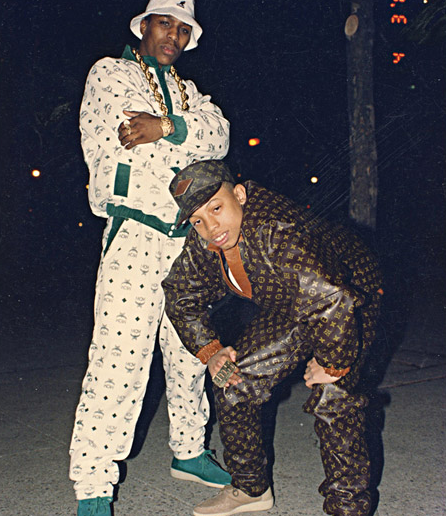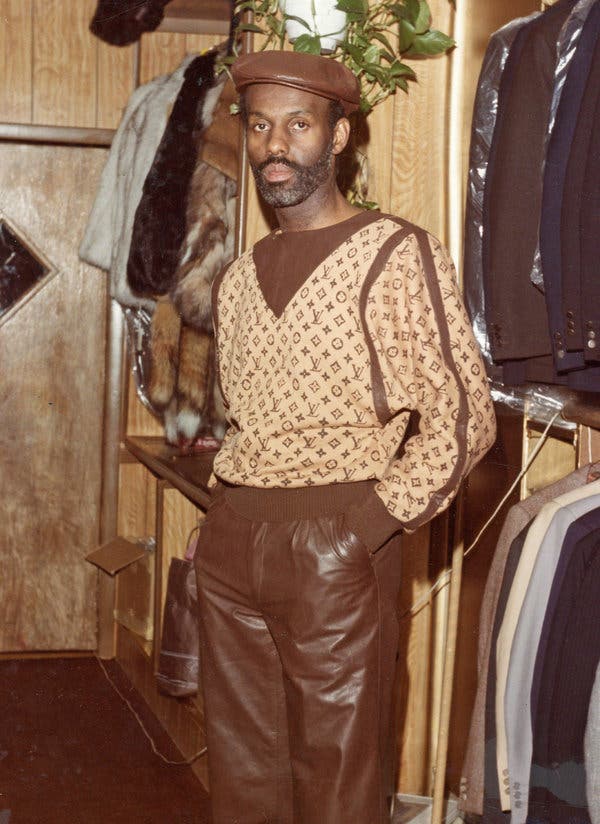Dapper Dan: Boujee Redefined
- jaime hafner

- Apr 17, 2020
- 5 min read
I can’t be the only one sending my momma links to sneakerhead instagram pages, begging her to drop $300 for Christmas on those sick customs. You know what I’m talking about. The elevated Air Force 1’s with an LV bag cut as a swoosh or an Off-White belt as the tongue. Incredible. Genius. Visionary. Who would’ve thought to take luxury garments and upcycle them into something completely fresh!? Well… Dapper Dan, that’s who! And all the way back in the 80’s too, when there was no such thing as social media *gasp*.

Daniel Day was born in Harlem on August 8th 1944. He grew up in poverty, as many families of color did at the time. By age 13, he had mastered the art of gambling. Mans was finessing bank earlier than most of us learned basic algebra. Okay, maybe I still don’t know basic algebra, but that’s besides the point. His skills earned him his nickname when he consistently beat old man Dapper Dan at craps, and so the name was passed down to him. He became a frequent user of opium but after listening to a few Malcolm X speeches, he got sick of running the streets. The speeches really resonated with him and led him to furthering his education through a program sponsored by Columbia University and the Urban League.
Dap involved himself with organizations like the Black Panthers, the Nation of Islam, and the Mighty Black Zulus. He eventually gave up drugs, alcohol, and smoking and even became vegetarian. In 1968 he got the chance to visit Africa through his studies, where he bought many African renditions of the “westernized, American suit” made by local tailors.
Upon his arrival back in New York in 1974, he began his career in the fashion industry, buying shoplifted clothes and boosting out of his car. Let me repeat that. OUT OF HIS CAR. Money moves, man. He opened Dapper Dan’s Boutique in 1982 on 125th St. between Madison and 5th, hoping to be a wholesaler, but most companies and big brands refused to do business with him due to his race. He ended up benefiting from this prejudice, deciding to take matters into his own hands and come up with his own designs. Inspired by the African tailors who had made prized suits, he pushed himself to learn about design, textile printing, and other skills of the industry. All of which were self-taught.
Dapper Dan's signature pieces are his “knock-ups,” reworking the logo prints of luxury brands such as Gucci, Louis Vuitton, and Fendi into his own designs. But prior to his discovery of logomania, his primary medium for garments was fur. Fur and diamonds were the biggest signifiers of clout for gangsters and drug dealers, who were originally his main clientele. Through his hustler constituency, particularly kingpin James “Jack” Jackson, he had come to realize the importance of symbolism. Jack came into the store with a Louis Vuitton pouch (the contents of which consisted of a couple bands, naturally) that everyone was obsessing over. Dap realized it wasn’t the material of the fabric that held its value, it was the logos on it and what those symbols represented. He discovered that logos were, and still are, visual representations of wealth and success just as much as mink coats and bling. This epiphany was the defining moment of his career. In an interview with the New York Times in 2017 he stated, “The label is the thing the gangster clientele use to let the other gangsters in the street know, ‘You ain’t got what I got.’”

The most quintessential of Dapper Dan’s designs are the print-and-mink coats. These iconic reversible bombers feature Louis Vuitton brown leather and a mink lining, gracefully combining his two trademarks in a fur-logo love affair. Dap told the New York Times that logomania was his biggest fashion achievement. The print-and-mink LV coats symbolize his journey as a designer, highlighting his beginnings as well as his claim to fame.
His involvement with hip hop fashion began in 1985 when he first styled LL Cool J. Since then he became associated with hip hop royalty, fitting icons like The Fat Boys, Salt N Pepa, KRS-One, Bobby Brown, Jam Master Jay, and Big Daddy Kane. Eric B. and Rakim even wore his designs on the album covers of Paid in Full and Follow the Leader. Dapper Dan is considered synonymous with and essential to the Golden Age of hip hop. He went on to create pieces for epochal black athletes like Mike Tyson, Floyd Mayweather and Diane Dixon.
In the years preceding Dapper Dan, the black community and the world of high fashion did not mix. Subsequent to the Civil Rights Movement, communities of color remained predominantly impoverished and so were not considered as part of the target audience of luxury fashion houses. Dapper Dan’s knock-ups of highbrow brands changed the game completely. Luxury labels were no longer limited to the white bourgeoisie. He taught an entirely new demographic how to interact with high end fashion and redefined the luxury clientele.

The store was shut down indefinitely in 1992 after a lawsuit by Fendi. He was shunned by the fashion world and went underground until he began outfitting Mayweather in 1999. His career was reborn in 2010 but he only started receiving mainstream attention again in 2017 when Gucci’s creative director, Alessandro Michele, designed a jacket based off a Dapper Dan fur coat with enormous LV puff sleeves made for Diane Dixon in 1989. This led to the birth of a partnership and the opening of Dapper Dan of Harlem, his new store in collaboration with Gucci located on Lenox Ave. The new atlillier is the very first luxury store in Harlem, furthering the integration of the black community into high end fashion and paying tribute to the streets that made him.


Dapper Dan has only recently started to receive the recognition owed to him since 1982. His career thus far already contains an absurd amount of cultural significance and the best part is he’s just getting started. His knock-ups revolutionized the fashion world. So, when you’re sitting by the tree next Christmas morning, crying happy tears about your brand new AF1 LV knock-ups, don’t thank your momma, thank Dapper Dan! (But actually though please do thank your momma cause those shoes are guap, and also you love her). Through artistic appropriation he exposed the ways in which the owners of these brands were falling short creatively and failing to utilize the power of their symbols. Dap’s legacy is so much bigger than sick customs. He is the leading reason why black culture and luxury fashion cease to be parallel worlds. And it all started from selling boonked shit out of his car.
References:
High Snobiety
The LA Times
The New York Times
_edited.jpg)



























Comments